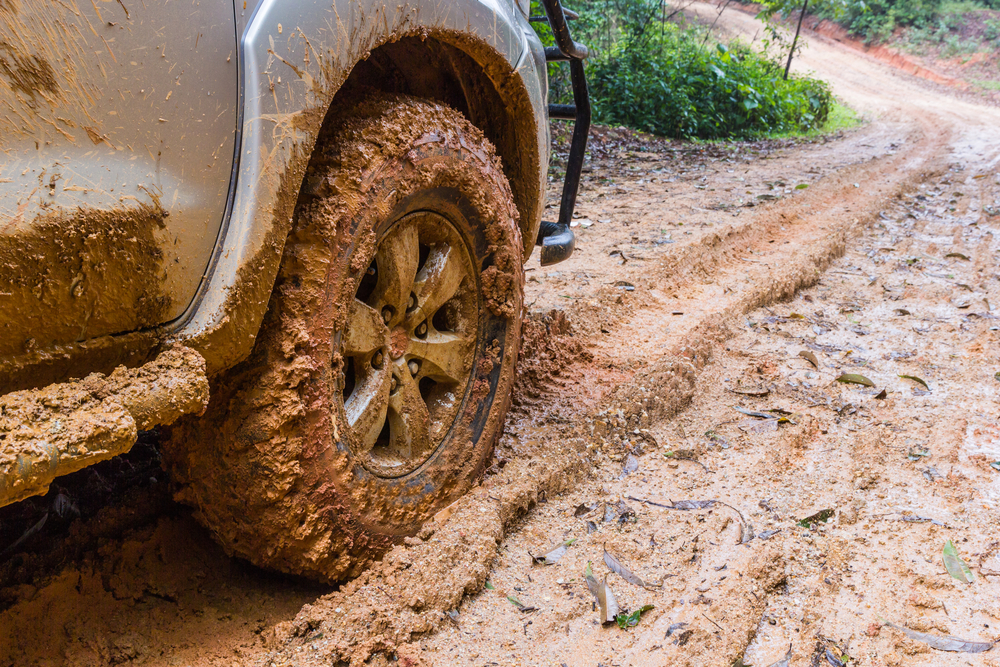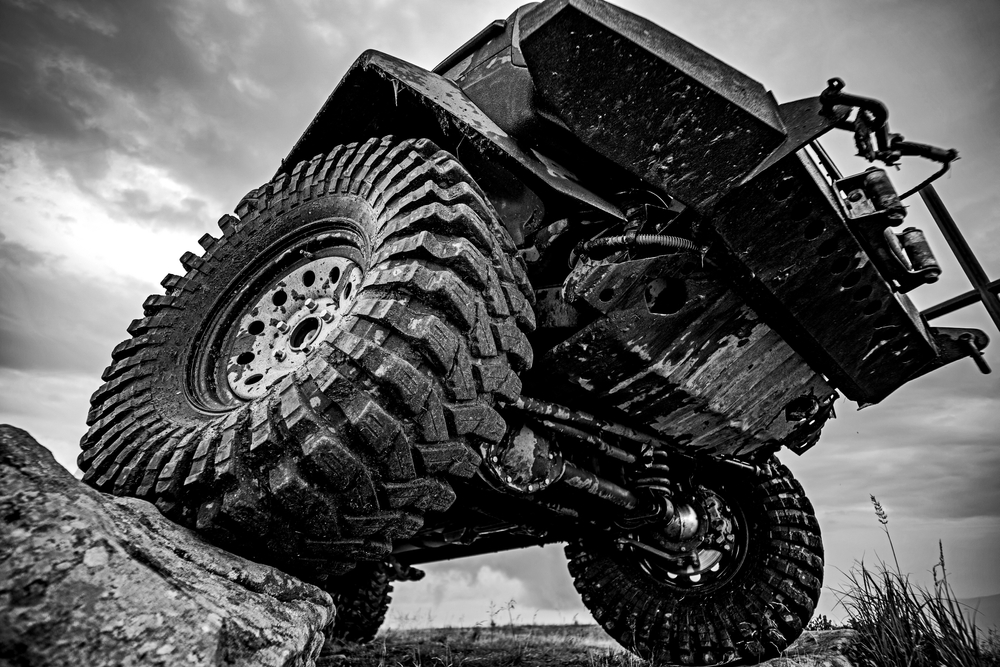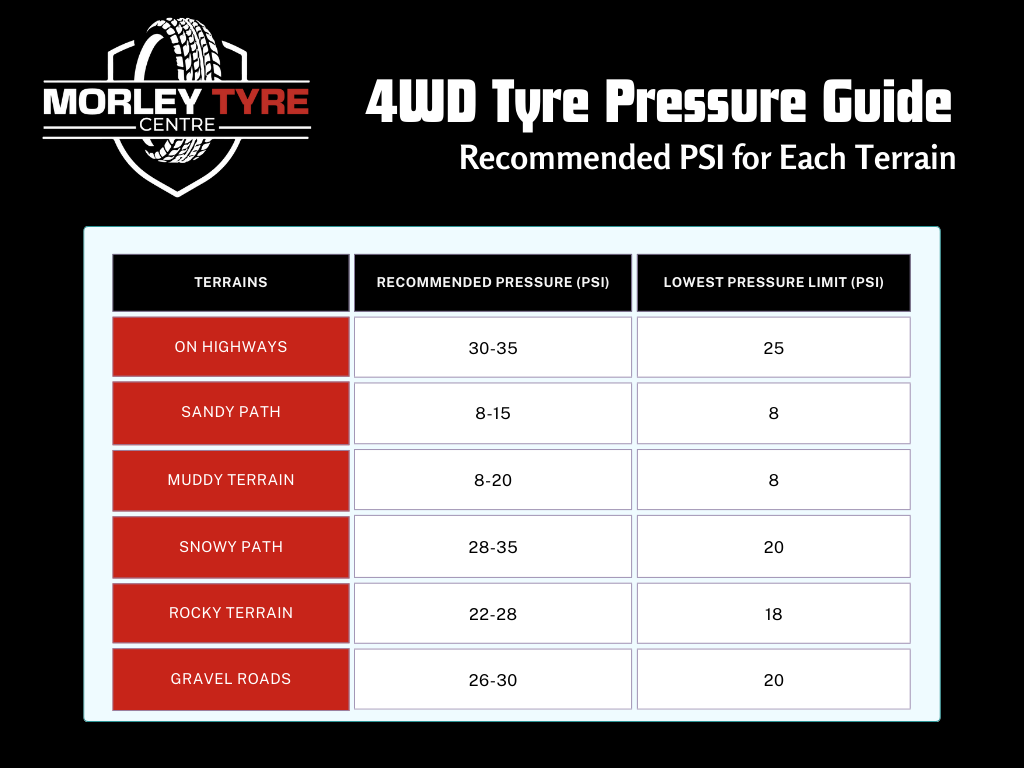Complete 4x4 & 4WD Tyre Pressure Guide for Diverse Terrains

Nothing beats the thrill of taking your 4WD off the beaten track.
You’re kicking up dust and powering through rugged terrain. The sun’s shining, the engine’s roaring, and then, bam! You suddenly lose control & your 4WD sinks into soft mud.
What went wrong? Well, your 4WD tyre pressure wasn’t set correctly for the terrain.
The wrong pressure can make your ride bumpy, cause excessive tyre wear, or leave you stranded in the middle of nowhere. But don’t worry, we are here to the rescue.
At Morley Tyre Centre, we’ve been keeping 4×4 tyres in peak condition for over a decade. If you need to buy 4×4 tyres, check your 4WD tyre lifespan or need expert advice. Our team has the knowledge and experience to keep you rolling.
Let’s start our 4×4 tyre pressure guide to help you drive confidently on any terrain.
Why Should You Adjust Your 4WD Tyre Pressure?
Adjusting your 4WD tyre pressure impacts their durability and safety. Here’s why it should be adjusted while changing terrain.
Factor | Effect of Proper Tyre Pressure |
Traction & Handling | The right pressure helps your tyres grip the surface and prevent skidding or getting stuck. |
Ride Comfort | Properly inflated tyres absorb shocks better, making off-road driving smoother and reducing stress on your suspension. |
Fuel Efficiency | Low pressure increases rolling resistance, making your engine work harder and burning more fuel. |
Prevents Punctures | Lower pressures allow tyres to flex around obstacles instead of getting cut. |
Safety | Incorrect pressure can lead to blowouts or loss of control on challenging terrains. |
Tyre Longevity | Keeping the right pressure prevents premature tyre damage and enhances the life of 4×4 tyres. |
Not sure how much should you adjust it? Here are some suggestions from expert mechanics.
Recommended 4WD Tyre Pressure for Different Terrains
With using the right 4WD tyre pressure chart. You can adjust your tyre pressure depending on where you’re driving.
Here’s a list of ideal pressures for various terrains:
1. On-Road (Bitumen & Highways)
Recommended Pressure: 30-35 PSI
Why? For even tyre wear, better fuel economy, and a smooth ride.
Pro Tip: Regularly check your tyre pressure. As high-speed driving causes heat buildup, which can alter pressure.
Most vehicles have a recommended 4WD tyre pressure chart inside the driver’s door or in the manual. Stick to it for everyday driving.
2. Muddy Terrain
Recommended Pressure: 8-15 PSI

Why? Lower pressure spreads the tyre footprint. Helping it grip the muddy surface instead of sinking.
Pro Tip: Avoid sudden braking, as lower pressures can make steering feel softer.
In deep mud, momentum is key. If you stop, getting out will be a struggle. Lowering your 4×4 tyres’ pressure improves traction and reduces wheel spin.
3. Sand Driving
Recommended Pressure: 8-20 PSI

Why? Lower pressure increases the surface area of your tyres. Preventing them from digging into soft sand.
Tips: Make slow & steady movements and avoid sharp turns to prevent rolling a tyre.
Sand driving is all about floatation. Your tyres need to “float” over the surface rather than dig in. Dropping your 4WD tyre pressure significantly is important in dunes and beaches.
4. Snowy Conditions
Recommended Pressure: 28-35 PSI

Why? Snow requires some deflation for better grip but not as much as sand or mud.
Tips: Chains can be used for extra traction in deep snow.
Most parts of Australia don’t see much snow. But if you’re heading to the mountains, adjust your 4WD tyres accordingly.
5. Rocky Terrain
Recommended Pressure: 22-28 PSI

Why? Lower pressure allows the tyres to mould over rocks. That improves grip and reduces the risk of punctures.
Tips: Drive slowly and carefully. Sharp rocks can damage tyres even at the right pressure.
Rocky trails can be brutal on your tyres. The key is to let them flex around rocks rather than bouncing off them, which could cause sidewall damage.
6. Gravel Roads
Recommended Pressure: 26-30 PSI
Why? Slightly reduced pressure absorbs the shocks from uneven surfaces and improves grip.
Tips: Avoid sudden braking to prevent skidding.
Gravel roads can be deceptive. They seem firm but loose stones cause difficulty in control. Slightly lower pressure helps with stability.
How Much Air-Down is “Too Low”?
While adjusting psi, the limit of how long you can go is as important as the deflation.
Dropping tyre pressure too much can cause handling issues, rolling resistance and increased fuel economy. It can also result in punctures and tyre damage. And can even lead to the tyre bead popping off the rim.
Signs That Your Tyre Pressure is Too Low
If you go beyond the safe limit, you will notice:
- Sidewalls bulging excessively, increasing the risk of cuts and punctures.
- Sluggish steering response, making it harder to control your vehicle.
- Excessive heat buildup, which can weaken the tyre structure.
- Tyre bead separation causing a total loss of air.
While each vehicle and tyre type are different. Here are some general limits of how low you can air-down safely.
Safe Minimum Pressure for Different Terrains

Keep in mind that these recommended values can vary according to the specific conditions you are facing. Read on to find out how.
Things to Consider When Adjusting 4WD Tyre Pressure
Various factors influence how your tyres perform at different pressures. So, you need to take them into account before making adjustments.
Those factors include:
1. Wheel Diameter
The size of your wheels impacts how your tyres respond to pressure changes. A larger wheel diameter means a smaller tyre sidewall. And reduced flexibility in deflating tyres for off-road conditions.
If your 4WD has aftermarket wheels that are significantly larger than stock. You should be cautious about reducing pressure too much. As it could expose your rims to damage from sharp rocks or other hazards.
2. Tyre Aspect Ratio
The aspect ratio is the height of the sidewall as a percentage of the tyre width. Lower aspect ratio means shorter and stiffer sidewall making deflation riskier. While higher aspect ratio with taller sidewall is more flexible.
If your 4WD tyres have a lower profile. Reducing pressure too much can cause sidewall pinching or even bead separation from the rim.
3. Vehicle Weight
The weight of your 4WD also determines the correct tyre pressure. Lightweight vehicle safely runs lower pressures off-road. But, if your vehicle is heavy, the tyres need extra air to support the weight and prevent excessive sidewall flexing.
So, if you’re carrying a roof rack, camping gear, or towing a trailer. You should increase your tyre pressure to support the additional load.
4. Type of Tyres
The type of tyres you have on your 4WD determines how they handle different pressures.
- Mud-Terrain (MT) Tyres: More resistant to damage when running low pressures.
- All-Terrain (AT) Tyres: They can handle moderate pressure adjustments.
- Highway (HT) Tyres: These tyres don’t perform well at low pressures off-road.
High-quality 4WD tyres give you more flexibility when adjusting pressures. While cheaper tyres don’t hold up well under deflation, with the risk of sidewall failure.
5. Driving Habits
Your driving style should influence how you set your 4WD tyre pressure. If you drive aggressively. Taking corners fast, braking hard, or accelerating quickly. Tunning low tyre pressure can make handling unpredictable.
Now, let’s get into details of how a misfit tyre pressure can impact your vehicle negatively.
Impact of Tyre Pressure on Tyre Lifespan
The way you manage the pressure directly impacts how long your 4WD tyres last. Incorrect pressure, whether too high or too low, can shorten the life of 4×4 tyres.
Let’s see how.
Effects of Overinflation
If your tyres are inflated beyond the recommended pressure, you will experience:
Uneven Wear | The centre of the tread wears out faster than the edges. |
Reduced Traction | Less tyre surface makes contact with the ground, reducing grip. |
Harsh Ride | Tyres become stiff, making bumps and potholes more jarring. |
Risk of Punctures | Stiff tyres are more prone to punctures on rocky terrain. |
Effects of Underinflation
Running tyres at too low pressure for extended periods can cause:
Increased Wear on the Edges | More tyre contacts the road, leading to premature wear. |
More Rolling Resistance | The engine has to work harder, reducing fuel efficiency. |
Sidewall Stress | Excessive flexing weakens the tyre, with more risk of blowouts. |
Heat Buildup | Too soft tyres generate more heat, which can lead to internal damage. |
Let’s talk about how to maximise your 4WD lifespan via the right pressure adjustments.
8 Expert Tips to Maximise Your 4WD Tyre Lifespan
Transitioning between different terrains requires quick and effective tyre pressure adjustments. Otherwise, even the best tyres for 4-wheel drive can fail.
Here’s how to do it right:
- Stick to recommended pressures for on-road driving to prevent uneven wear.
- Adjust pressure gradually based on terrain, rather than making extreme changes. Drop 2-3 psi, check the tyres, and then proceed.
- Check your tyre pressure regularly, especially before off-road trips.
- Always use a quality pressure gauge to get accurate readings.
- After airing down for off-road driving, you’ll need to reinflate before hitting the highway. So, carry a portable 12V air compressor with you.
- After off-road driving, inflate your tyres back to road pressures as soon as you return to bitumen.
- If you’ve been driving in the heat, allow tyres to cool before adjusting pressure.
- Use high-quality 4WD tyres designed for the type of driving you do.
Looking for a Reliable Source to Buy Tyres Online?
Visit Morley Tyre Centre
Morley Tyre Centre is here to help all off-road enthusiasts and everyday drivers.
Whether you’re looking for cheap 4×4 tyres online. Need a professional tyre fitting or pressure adjustment. Or want expert advice on extending your 4WD tyres’ lifespan. Our team can help you with that.
Drive with confidence, wherever the road (or lack of one) takes you!
